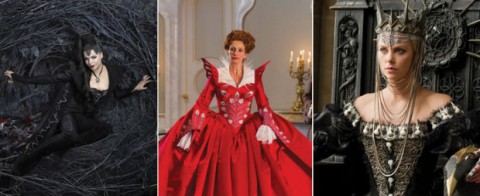Once Upon a Time; Mirror, Mirror and Snow White and the Huntsman

I’ve long imagined that the gender theorists at Walt Disney Productions are a bit embarrassed by the 1937 movie Snow White and the Seven Dwarfs, with its saccharine high-voiced heroine who longs for her prince to come. After all, recent Disney princesses make some feminist overtures. In Beauty and the Beast, the heroine Belle is a bookworm with no time for fluttering lashes; in The Little Mermaid, Ariel refuses the restraints of her sea king father; and in The Princess and the Frog, Tiana is a working woman, running her own restaurant with royal title in hand. Femininity as scripted by Disney represents no feminist victory, but it’s at least more complicated than it was decades ago. The princess tale of today can’t be told without some interaction with feminist critique.
Three current tales of Snow White all nod at feminist critique by putting weapons into Snow White’s hands. Nevertheless, the old paradigms for female power and beauty are left intact. The “fairest of them all” is none other than we’d expect her to be: she is very young, very rich and very, very white.
Once Upon a Time, which begins its second season this month on ABC, features Snow White (Ginnifer Goodwin) and Prince Charming, who have been banished by the evil queen (played by Lana Parrilla) to small town USA. The show moves between the past, the land of magic, and the present, where Snow White and company have forgotten who they are. Snow White is a schoolteacher, and the prince has been in a coma. Their daughter, now seemingly the same age as Snow White, generally upstages them both. The queen’s hatred for Snow White is rooted in an old grudge. When Snow White was a child, she was tricked by the evil queen’s mother into disclosing the young queen’s love for a stable boy. The evil mother, clinging to her plan to wed her daughter to the king, kills the stable boy, and the queen then directs her vengeance at Snow White.




